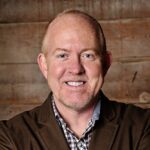WHAT
The Big Idea
A couple of weeks ago, I hosted Larry Osborne for our Leadwell Accelerator. Some of you joined us for what proved to be a very insightful session. For those that didn’t, Larry is a pastor at North Coast Church. He’s an author, mentor, and leadership consultant. And he’s coached thousands of leaders, not only in the church but also in for-profit sectors as well. You probably recognize his name from some of his pioneering work with concepts like sermon-based small groups, pastoral teaching teams, and of course, video venues. I call him the grandfather of video venues in multi-site churches. His fingerprints are found in ministries and churches across the country and really around the world.
I asked Larry to talk some about what he thought the next wave of multisite was going to look like. In a power-packed 20 minutes, he shared the importance of defining what you mean by multisite and understanding your motivation for launching campuses. You can listen in on these thoughts at the link to the full conversation below, but I want to recap a few of Larry’s observations for you in this post.
Some Things Will Stay the Same
Twenty Minute Drive Barrier – Come and see evangelism and youth involvement disappear at about a 20-minute drive time. At North Coast, they started multisite not to grow the church bigger, but to increase those two things. In a church with strong teaching, the teaching ministry is one of the major draws. So, they continue to bring the teaching team to people outside the 20-minute barrier via video and launch with a full children’s, youth, and strong worship ministry so that people will quit driving.
Geographical Barriers – Successful campuses are almost always regional. There are few outliers who have learned to launch a campus outside their regions because of the national presence of the senior leader. In addition, microsites are cross-regional and national but they seldom become campuses.
Complexity barriers – A lot of things hit a ceiling because of complexity. You know, if there are two people or two campuses or two services and you work together, you have two lines of communication. You go to three campuses, you have six, you go to four, you have 12, you go to five, you have 20 and it exponentially increases its complexity. Larry believes that the future will include a lot of churches with one or two campuses, fewer with three or four, and very few with four or more.
Some Things That Must Change
Move from Macy’s to Home Depot – Pre COVID, most churches viewed their websites as a tool to drive foot traffic. That was Macy’s strategy as well. When things opened up a bit before being shut back down with Delta, the Wall Street Journal had an article indicating that Macy’s was quite pleased that the foot traffic had increased because that was their predictor of sales. Compare that to Home Depot, Target, Walmart, and other places that are totally agnostic about where the sale takes place. They know that sometimes customers want to come into the store for a purchase. Others are perfectly fine purchasing online because they know exactly what the product is and want it quickly. They move back and forth and are happy with that rhythm.
Many of us are still using the online connection as a way to drive people back to church. We even use language like “come back.” At North Coast Church, since they reopened, they simply say, “We’re happy to give you a physical option.” They don’t want those who, for whatever reason, aren’t coming back, to feel like they’re mad at them or that they’re second class. Larry noted, “Frankly, the main people who feel like everybody’s got to be in the room are those of us that are on stage; the speakers and the worship leaders.”
Stop Using the Internet as a Funnel – We have to stop looking at the internet as a tool through which you’re trying to get people down the funnel to physically show up. Larry noted that North Coast looks at its online audience through three lenses.
- Content – these are the people who just show up on the North Coast site to get some content. The NC team is honored that they’re there for that but they’re not trying to turn them into North Coasters. That traffic is driven by things like somebody hearing a sermon and sending it off to their friend, saying, “You need to watch this.” Larry estimates that 50% of their traffic is made up of content purveyors.
- Connected – This is like the old-school radio show where people would listen every day to X, Y, and Z pastors. They’re connected because they listen a lot or watch a lot. They might even send an occasional offering to keep you going. This group represents about 40%.
- Committed – This group accounts for about 10% of the online audience at North Coast. They’re gathering people. They’re giving on a regular basis. And in some contexts like small groups and serving opportunities, they show up in person. North Coast focuses on the committed and serves them well through their campuses.
Larry compared using the internet as a funnel to going to a trade show and walking away with a stack of business cards that have to be triaged. Some of the people just wanted whatever your free giveaway was and others wanted to buy what you are selling. If I treat everybody as a potential customer, I don’t have enough time, or energy to invest in the true customers.
SO WHAT
The Implications
As is the case coming out of all cultural inflection points, some things remain constant while others change. It seems kind of obvious but I find that oftentimes leaders focus on one side of the equation or the other. This is driven largely by leadership style, personality, and sometimes fatigue. The key is a holistic review.
Take some time to review your multisite plans (and other strategies for that matter) and determine, based on your context, what will continue and what must change.
NOW WHAT
The Resources
As mentioned earlier these thoughts from Larry represent just a snippet of the content he shared during the Leadwell Accelerator. In addition to his full thoughts, you can listen in on the conversation with Jeff Kahler from Lives Changed by Christ as he shares about their effective merger model. You will also hear from Bruce Smith at College Park Church in Indianapolis and their “family of churches” multiplication model.
You can watch the entire episode here.
Perhaps as you begin to navigate next, you could use the help of an experienced guide. I’ve been working with multisite churches for close to twenty years and I’ve learned one constant – if you’ve seen one multisite church, you’ve seen one multisite church. Let me help you reimagine what’s next for your church’s multisite strategy. You can sign up for a free consult here.
WHO KNEW
Factoids and other random thoughts
Did you know that:
- 84% of multisite directors prefer campus pastors who have previously done an internship or ministry residency (and 29% of campus pastors did complete one or the other)?
- 59% of multisite churches, when their first campus launched, had as a part of the vision to start additional campuses (and 85% say it’s “very much” part of their vision today)?
- 68% of multisite churches have added a new campus in the last three years?
- 79% of multisite campuses were self-sustaining by the end of year three?
These are just a few of the preliminary findings in North America’s largest-ever research on church planters, founding pastors, multisite innovators, and church multiplication movement leaders.
If you haven’t completed the survey that I am working on with Dr. Warren Bird at ECFA (Evangelical Council for Financial Accountability) to discern the emerging “new normal” of church multiplication – what’s working well, what’s changing, where are the pinch points, and what are the breakthrough discoveries, will you do so today? Should take 15 minutes or less. Here’s the link for the survey.



0 Comments